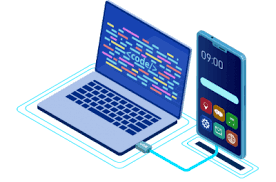In the fast-paced world of mobile technology, launching an app is just the beginning. The real challenge begins after your app goes live—when bugs appear, updates are needed, and user expectations evolve. Whether you’ve built a gaming app, an e-commerce platform, or a service-based utility, ongoing maintenance is essential for success.
As a Dallas mobile app development company, we understand the importance of maintaining and improving your app post-launch. In this comprehensive guide, we’ll share practical mobile app maintenance tips to ensure your application remains secure, competitive, and user-friendly.
Why Mobile App Maintenance Is Essential
Before diving into tips, let’s address the “why.”
Here are the top reasons app maintenance is crucial:
- Bug Fixes: Even the best-tested apps can encounter bugs.
- User Expectations: Users expect seamless performance and modern UI/UX.
- Security Updates: To protect user data and comply with evolving regulations.
- OS and Device Updates: iOS and Android frequently roll out updates, which can affect how your app runs.
- Performance Optimization: Apps can slow down or become unresponsive without regular tweaks.
Maintaining your app is like servicing your car—you might not notice issues until it’s too late unless you’re proactive.
Tip #1: Monitor App Performance Regularly
One of the first steps in mobile app maintenance is consistent performance monitoring. This means keeping track of:
- App crashes and freeze rates
- Load times
- Battery and memory usage
- User behavior and retention metrics
Tools like Firebase, Crashlytics, New Relic, and Google Analytics can provide real-time insights into how your app is performing.
A professional Dallas mobile app development company always integrates performance tracking tools to detect issues early.
Tip #2: Prioritize Bug Fixes and User Feedback
App reviews often contain a goldmine of information. Users will let you know what’s not working, what’s missing, and what they love.
Best Practices:
- Monitor app store reviews frequently.
- Use in-app feedback prompts.
- Respond quickly to critical bug reports.
- Maintain an internal backlog of issues and fixes.
Delays in fixing bugs can frustrate users and damage your brand’s reputation. Quick action shows professionalism and builds trust.
Tip #3: Stay Updated with OS Releases
Apple and Google roll out frequent updates for iOS and Android, which can create compatibility issues with your app.
How to Handle It:
- Subscribe to OS developer newsletters.
- Participate in beta testing of new OS versions.
- Test your app’s functionality immediately after updates.
A reliable Dallas mobile app development company will test your app across multiple devices and OS versions, ensuring full compatibility.
Tip #4: Optimize for New Devices and Screen Sizes
Every year, new phones and tablets enter the market—with varying screen sizes, resolutions, and hardware capabilities.
Your app needs to adapt to these changes. Otherwise, you risk offering a broken experience to users on the latest devices.
Key Areas to Focus:
- Responsive UI design
- Device-specific bugs
- Touch gestures and hardware features
- Performance on lower-end devices
Optimizing your app ensures that it delivers a seamless experience across the board.
Tip #5: Schedule Regular Security Audits
Security should never be an afterthought. Data breaches can cost you not just money, but user trust.
Conduct security checks on:
- Data storage and encryption practices
- User authentication processes
- API vulnerabilities
- Third-party SDKs
A seasoned Dallas mobile app development company will implement regular security checks and ensure compliance with GDPR, HIPAA, and other standards relevant to your industry.
Tip #6: Update Content and Features Frequently
Apps aren’t just software—they’re a direct line to your audience. Keeping the experience fresh encourages users to return.
Here are a few ways to do that:
- Add new content (e.g., blog posts, offers, tutorials)
- Roll out new features periodically
- Run promotions or contests
- Push timely notifications
Even minor changes like UI enhancements or seasonal themes can make your app feel fresh and updated.
Tip #7: Back Up Data Consistently
Data loss due to unexpected crashes, hardware failures, or cyberattacks can cripple your app’s functionality.
Tips for Data Backup:
- Automate daily or weekly backups
- Use secure, encrypted cloud storage
- Store backups in multiple locations
- Regularly test your restore process
This simple maintenance habit can be a lifesaver in emergencies.
Tip #8: Review and Update Third-Party Integrations
Most apps use third-party services like payment gateways, chatbots, analytics tools, or push notification services.
However, these SDKs and APIs are frequently updated or deprecated.
Maintenance Checklist:
- Review API documentation regularly
- Replace deprecated libraries
- Test each integration post-update
- Monitor service-level agreements (SLAs)
A proactive Dallas mobile app development company ensures all integrations are smooth and up-to-date, avoiding service interruptions.
Tip #9: Run Regular App Store Optimization (ASO)
Maintenance doesn’t stop with the app’s code. Visibility in app stores is just as important.
ASO Best Practices:
- Update screenshots to reflect new features
- Rewrite descriptions to align with trending keywords
- A/B test your app icon
- Collect and showcase positive user reviews
This can dramatically boost downloads, especially after major feature updates.
Tip #10: Track KPIs and Adjust Strategy Accordingly
Regularly monitoring KPIs (Key Performance Indicators) gives you a roadmap for improvements.
Some important mobile app KPIs include:
- Retention rate
- Daily/monthly active users (DAU/MAU)
- Lifetime value (LTV)
- Churn rate
- Average session length
If your metrics are dropping, it’s time to reevaluate your UX, features, or marketing approach.
Bonus Tip: Automate Where Possible
Maintenance doesn’t have to be manual or time-consuming. Automating certain processes can save resources and reduce human error.
What You Can Automate:
- Crash reporting
- Security scans
- Backups
- Push notification scheduling
- Performance testing alerts
As an experienced Dallas mobile app development company, we help clients set up automated systems that streamline post-launch workflows efficiently.
How Often Should You Maintain Your App?
Here’s a basic maintenance schedule to follow:
| Task | Frequency |
| Performance review | Weekly |
| Security audit | Monthly |
| OS compatibility check | Quarterly or during updates |
| Feature updates | Every 2–3 months |
| Bug fixes | As needed (immediately after discovery) |
| User feedback analysis | Weekly |
| Content updates | Monthly |
You don’t have to do everything at once—but consistent, planned efforts will keep your app in top form.
Final Thoughts
Mobile app maintenance is an ongoing responsibility that plays a critical role in your app’s success. Neglecting it can result in buggy experiences, unhappy users, and declining downloads. On the other hand, proactive maintenance keeps your app secure, functional, and engaging.
If you’re looking for a trusted partner to handle not just development, but long-term mobile app care, collaborating with a seasoned Dallas mobile app development company is your best bet.
Why Choose Appingine?
At Appingine, we specialize in full-cycle mobile app services—from ideation to development, deployment, and most importantly, post-launch maintenance. As a leading Dallas mobile app development company, we pride ourselves on delivering:
- Proactive bug detection and resolution
- Seamless OS and device compatibility
- Real-time performance monitoring
- Frequent updates based on user feedback
- Bulletproof security practices
- ASO and user retention strategies
Whether you’re launching a new product or refining an existing one, Appingine ensures your app is always ahead of the curve.








